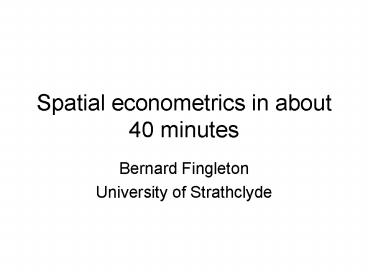Spatial econometrics in about 40 minutes - PowerPoint PPT Presentation
1 / 41
Title:
Spatial econometrics in about 40 minutes
Description:
The standard time series econometric tools are not relevant for spatial ... Second 'Spatial Econometrics Advanced Institute' that will be held again in Rome ... – PowerPoint PPT presentation
Number of Views:225
Avg rating:3.0/5.0
Title: Spatial econometrics in about 40 minutes
1
Spatial econometrics in about 40 minutes
- Bernard Fingleton
- University of Strathclyde
2
Spatial econometrics in about 40 minutes
- Why spatial econometrics?
- Spatial economics now widely recognised in the
economics mainstream - Krugmans Nobel prize for work on economic
geography - Importance of network economics (eg Royal
Economic Society Easter 2009 School , on
Auctions and Networks) - LSE ESRC Centre for Spatial Economics
- Increasing policy relevance World Bank (2008),
World Development Report 2009, World Bank,
Washington. - The standard time series econometric tools are
not relevant for spatial series
3
What is spatial econometrics?
- the theory and methodology appropriate to the
analysis of spatial series relating to the
economy - spatial series means each variable is distributed
not in time as in conventional, mainstream
econometrics, but in space.
4
DGP for time series
5
DGP for time series
6
DGP for time series
7
DGP for time series
8
DGP for time series
9
DGP for spatial series
W
10
DGP for spatial series
11
DGP for spatial series
12
DGP for spatial series
13
DGP for spatial series
14
Spatial versus time series
- problem concerning W
- Close together in time is easily defined
- There are many different metrics for measuring
closeness in space - The simplest is contiguity(1,0), where locations
1 denotes locations sharing the same boundary - Some alternatives for W
- straight line distance
- great circle distance
- economic distance trade costs, market access
- travel time
- distance in market product space if the n
objects are say companies and not places - social network distance between people
15
Some typical models
16
Some typical models
17
Estimation
- ML typically used but problems..
- No large sample theory
- Fails to handle other endogenous variables on
rhs, i.e. excluding spatial lag (Wy) - Assumes normality, or some other specific
distribution, 2SLS/GM robust - ML requires eigenvalues of W matrix, if N large
this may be problematic
18
Some typical models
19
Estimation
20
Some applications
21
The NEG wage equation
22
The NEG wage equation
23
The NEG wage equation
24
Some applications
25
Some applications
26
Some applications
27
Some applications
Bernard Fingleton and Julie Le Gallo "Estimating
spatial models with endogenous variables, a
spatial lag and spatially dependent disturbances
Finite sample properties Papers in Regional
Science, Volume 87, Number 3, August 2008.
Results can be replicated in Stata
28
Some applications
- http//www.sml.hw.ac.uk/ecomes/peebles/
- Contains Stata data file
- Stata do file
- Stata log file
29
English house prices in 2000
30
English house prices in 2000
31
DGP for spatial series
W
32
English house prices in 2000
33
English house prices in 2000
34
International shock transmission
35
International shock transmission
36
International shock transmission
37
International shock transmission
38
International shock transmission
Impact of a positive shock (3 s.d.) to the UK On
real GDP pw
39
spatial econometrics software
- MATLAB
- Many routines available on James LeSages
webpages - Advanced spatial econometrics using MATLAB,
available from - http//www.spatial-econometrics.com/
- Stata
- Some routines forthcoming and available
- David Drukker's package. When available, The
package is described here http//repec.org/snasug
08/drukker_spatial.pdf.
40
Course
- Second "Spatial Econometrics Advanced Institute"
that will be held again in Rome in Amy-June 2009.
The deadline for applications is the end of
January. All the details may be found at the
website Www.Spatialeconometricsadvancedinstitute.o
rg
41
books
- Anselin L (1988) Spatial Econometrics Methods
and Models. Dordrecht Kluwer. - Anselin L (2001) Spatial Econometrics, in B.
Baltagi (ed) A Companion to Theoretical
Econometrics, Blackwell Oxford, 310-330 - Anselin L (2006) 'Spatial econometrics' in TC
Mills and K Patterson (eds) Palgrave Handbook of
Econometrics vol 1 Econometric theory Palgrave
Macmillan 2006 901-969































